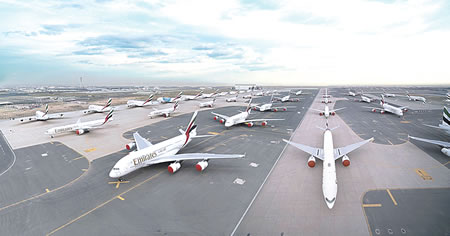A review of the International Civil Aviation Organisation (ICAO) Safety Report of 2020 has indicated that in 2019, globally, there were a total of One Hundred and Fourteen (114) aviation accidents, six (6) of which were fatal with two hundred and thirty-nine (239) fatalities.
This 2019 global accident rate of 2.9 accidents per million departures is said to be the highest in the previous five years and represents an increase of 12 per cent from the year 2018 figure.
The director-general of the Nigerian Civil Aviation Authority (NCAA), Captain Nuhu Musa, declared this at a conference on ‘Prevention of human factors in air accident occurrences’ organized by the Accident Investigation Bureau (AIB) in partnership with aviation journalists in Lagos, Friday.
According to the NCAA DG, the same report showed that the African Indian Ocean (AFI) Region, to which Nigeria belongs recorded an accident rate of 2.8 accidents per million departures, though with one of the least estimated departures of one million four hundred and forty thousand, seven hundred and one departures (1,440, 701), representing only 3.8 per cent share of total global traffic. This is one of the highest accidents rates per region globally.
“It is common knowledge, widely propagated within the industry that at least 70 per cent of aviation accidents are contributed to Human Factors. However, a review of the Commercial Aviation Safety Team (CAST)/ICAO Common Taxonomy Team (CICTT) taxonomy for occurrence categories has shown that there is no category of these occurrences ascribed to “Human Factors”. While stating that an in-depth review of the established different CICTT categories will show that humans are somehow practically involved in or interface with all the occurrence categories, Captain Nuhu added: “This is the reason why the Safety Management Systems (SMS) classifies the above statement as a misconception as humans (especially frontline personnel) interface in almost, if not all probable causes of aviation accidents at the different stages of either design, production/manufacture, organizational, operational and maintenance processes and procedures.
“Human Factors can fundamentally and best be described as “Matching the Man (Person) to the Job and Matching the Job to the Man under the prescribed conditions”. This implies compatibility of the person to the job i.e. preparing, adapting, enabling, equipping and conforming the person to perform the assigned task to achieve the design and expected objectives. Any mismatch will contribute to human error and is a precursor to an accident.
“One of the best ways to explain the “Human Factors” contributory role in aviation accidents is a review of the “SHELL” Model made popular by Hawkins in 1987, which is a conceptual tool used to analyze the interaction of multiple system components including interactions with other Liveware (L). In the SHELL Model, the other components are classified as Software (S): Current, effective and applicable laws, rules, regulations, orders, policies, instructions, directives, Standard Operating Procedures etc. and the norms and best practices that establish and ensures the implementation of the functions, responsibilities and accountabilities of an organization.
Other ways to explain the human factors contributory role in aviation accidents according to the NCAA DG fall under Hardware (H): Most commonly referred to as the human-machine systems interface. And may include the operating equipment (aircraft, simulator), displays matching the sensory and information processing characteristics of the operator and controls with proper movement etc; and Environment (E): Which refers to those interactions which may or may not be out of the direct control of humans, namely the physical e.g. temperature, weather, etc., physiological and psychological environments but within which aircraft operations must continue to take place.
“Amongst these different components of the SHELL Model, the Liveware is the critical focus and represents the human component of the aviation ecosystem. These are the frontline personnel (flight crews, engineers and maintenance personnel, DATCOs) and the management and administration staff, who have usually removed far away from the frontline, but whose decisions impact massively on the outcomes of the operations.
Human Factors in aviation occurrences is therefore most times seen as the negative consequence of the liveware dimension in this interactive ecosystem.”
He, therefore, called on participants at the Conference to critically review the relationship between the liveware components and the other components of the aviation ecosystems and devise means towards achieving an effective and seamless safe aircraft operation and thereto preventing accidents due to human errors.
According to him, at areas to be exploited have wide latitude and may include: “Individual and organizational compliance with the statutory and regulatory requirements and conformance to approved policies and procedures, which must be implementable; design and production of the operating equipment to achieve its intended design objectives with optimal reliability and their adaptability for compatibility and fitness to the operator; implementation of Safety Management Systems (SMS) for identification of operational hazards, associated safety risks and implementation of appropriate risk management strategies to mitigate safety risks to acceptable and tolerable levels; and where the necessary application of appropriate enforcement actions where motivational intent to violate statutory and regulatory requirements are established to serve as deterrent amongst others.”
YOU SHOULD NOT MISS THESE HEADLINES FROM NIGERIAN TRIBUNE
#EndSARS: As British Parliament Hears Petition, UK Govt Says It Won’t Speculate On Sanctions
The British Parliament at the Westminster Hall held a debate on ‘e-petition 554150, relating to Nigeria and the sanctions regime’ on Monday. The government of the United Kingdom has however responded…Global aviation suffered 114 Global aviation suffered 114
2023 Presidency: APC Govs’ Meeting With Jonathan Sparks Controversy
The surprise visit made on Friday night by the leaders of the ruling All Progressives Congress (APC) to former President Goodluck Jonathan at his residence in Abuja triggered a stir in the major political camps, resulting in at least four possible theories..Global aviation suffered 114






